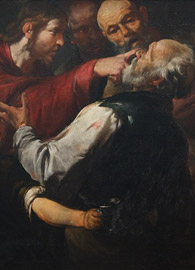John Week 5
From Sight to (Un)Belief: The Illuminating, Blinding Light: John 7:53–10:42
Seattle Pacific University Assistant Professor of New Testament
Read this week’s Scripture: John 7:53–10:42
14:57
Key Prologue Terms: light/darkness, life, testimony, sight, children of God
Light of the World

 Enlarge
Enlarge
The key statement of these chapters in the Gospel of John is simply this:
“I am the light of the world.” (8:12)
Most of us have used a flashlight at night. If you align yourself with the flashlight, the light source, you are able to see clearly in the dark. But if you look directly into the flashlight’s beam, placing yourself in opposition to it, you are blinded by the light. These next three chapters of John illustrate both the illuminating and the blinding aspects of light. They describe Jesus as that light and how others position themselves in relation to him.
Also, John’s gospel utilizes both the physical and spiritual meanings of the word “light” as he has done with other words before (e.g., “living water,” “bread of life”). This is illustrated by Jesus’ encounter with a man who is physically blind (9:1–7). Jesus heals the man’s physical blindness. At the same time, the healed man takes a journey from spiritual blindness to spiritual sight or understanding, exemplifying a follower of Jesus.
By opposing Jesus, however, the authorities continue to blind themselves to his revelation of God again and again and again. By the end of these chapters John describes this spiritual blindness as so entrenched it seems irreversible.
Illuminating Sin (7:53–8:11)
The first episode in these chapters is not Jesus declaring that he is the light of the world. Instead, John shows us the effects of Jesus’ illuminating and blinding light in the details of this passage. Jesus is tested (8:6) by the scribes and Pharisees who ask him what punishment he would advise for a woman caught in the act of adultery (8:4). The central element of the story is that Jesus perceives this as a test. The Pharisees and scribes have not followed the law in setting up this confrontation. They have provided no witnesses, as was required, and they have brought only the woman instead of the couple before Jesus. Under Mosaic law, both the man and the woman would be liable for the death penalty (see Leviticus 20:10; Deuteronomy 22:22). Jesus judges the situation not based on its appearances but with “right judgment” (John 7:24; 8:15).
By shining the light toward the sins of the woman’s accusers (8:7), Jesus convicts them of their sin (cf. 2 Samuel 12:1–15) while releasing the woman from hers (8:11). This time the accusers see. Jesus admonishes the woman, “Go your way, and from now on do not sin again” (8:11), the same advice he will give the healed blind man and has given the paralyzed man (5:14). Now Jesus declares that he is the light of the world (8:12). He illuminates a way toward an abundant life for her, as he has brought her literally and spiritually from the edge of death to life. [Author’s Note 1]
Illuminating Jesus’ Origins; Blinding Authorities (8:12–59)
Jesus remains in the Temple after his affirmation that he is the light of the world (8:12). This declaration takes on particular significance given that Jesus has just been at the festival of Booths (7:10). One of the components of Booths, besides celebrating living (running) water (7:37–39), is extolling light. In this way Jesus is declaring himself to be the culmination of the joyous festival.
This discussion about Jesus’ presence as light in the world (8:12–59) echoes the prologue and its allusions to creation. John claims that the darkness neither overcomes nor understands the light (1:5; see Lectio 1). The authorities will not overcome Jesus, and they do not understand him either (8:14).
The conversation here is primarily about origins, as it has been for several chapters. In theory, if people know the parents or ancestors of a person, they will know something about that individual. This works fairly well when we are talking about “normal” people: whether we want to admit it or not, family influences us in terms of genetics and/or in terms of environment. However, John’s point is that when it comes to Jesus we are dealing with someone different from us, and we need to reverse the process. Jesus wants people to know him and then understand more about God, rather than the other way around (8:19).
In the Gospel of John, knowing who Jesus is requires that the audience absorb two essential claims:
- Jesus is the Son of Man who is responsible for judgment (see 5:27) and who will be “lifted up” (8:28).
- Jesus is the “I AM” revealed in Exodus 3.
These two statements get to the heart of the paradox introduced in John 1 — the eternal Word of God becomes flesh (1:14) and dies, to be raised again and reign eternally with God (1:1, 18). [Author’s Note 2]
Jesus continues to use the name “I AM” to respond to the authorities when they ask him who he is. Translations often modify this statement so that it reads more clearly in English (“you will die in your sins unless you believe that I am he,” 8:24, NRSV). The conversation between Jesus and the authorities reads a bit more authentically if you read it this way:
Jesus: “…you will die in your sins unless you believe that I am.” (8:24)
Authorities [imagining that Jesus just forgot to finish the sentence]: “Who are you?” (8:25)
In this passage Jesus declares that he is the Son of Man who will be crucified (and therefore exalted) and will be the final Judge at the end of time. At the same time he is also the God who delivered Israel from slavery, made and fulfilled covenants with them, and loved and sustained them. It is no wonder the authorities cannot comprehend who Jesus is. This revelation is blinding because they oppose Jesus and stare directly into the light. [Author’s Note 3]
Illuminating a Man Born Blind; Blinding Authorities (again) (9:1–41)

 Enlarge
Enlarge
John 9 is the longest account of a miracle story and its repercussions in the gospels. It also contains the longest amount of narrative time that Jesus is not present on the scene (9:8–34). These two facts set this healing apart. In its context this healing seems to function as a way to answer the implicit question raised by John 8. If the Pharisees and other authorities are continually setting themselves against Jesus, blinding and deafening themselves to his revelation, then how does one move from blindness to sight, or from ignorance to understanding? The metaphorical implications of this healing provide that response. With Jesus’ healing initiative, the one who is healed has the ability to face trials and harsh questions that come his way. At the end he will be able to see (9:35–39).
Jesus declares that the man’s blindness is not caused by sin, whether his or his parents’ (9:3). In light of the previous discussion about the need to dissociate assumptions about ancestry from a judgment about an individual’s actions, John expects the audience to hear the irony in the disciples’ question. While this was a common assumption in the ancient world, Jesus denies that it has any place here. It is not sin that causes physical blindness.
The healing proceeds straightforwardly. As is common in John, the healed person does not articulate faith before Jesus heals him, though he does follow Jesus’ command to go to the pool of Siloam and wash (9:7). [Author’s Note 4] Yet it is not the healing that creates the problem in this text; instead, it is Jesus’ absence and the healed man’s testimony that take center stage.
The man is quizzed by neighbors (9:8–12) and by the Pharisees twice (9:13–17, 24–34). The Pharisees also question his parents (9:18–23). The man consistently displays composure in answering the questions. He states the facts of the experience as well as his interpretation of Jesus’ identity. In other words, he gives testimony. He determines that Jesus must be a prophet (9:17) and that the Pharisees must want to be Jesus’ disciples since they want to know so much about him (9:27, a verse dripping with irony). [Author’s Note 5]
The man’s experience concludes with his being pushed out of his community on account of his bold answers (9:34). Jesus meets him when he is apparently by himself. The formerly blind man has never seen Jesus, as Jesus disappeared before the blind man was healed. For the first time in the gospel, an individual responds to Jesus with a confession (“Lord, I believe.” 9:38) and in worship. This man has moved from physical blindness and spiritual blindness (ignorance) to physical and spiritual sight.
The concluding passage of this chapter demonstrates that while physical blindness has no connection with sin, spiritual blindness does. Sin, according to John’s gospel, is not perceiving Jesus rightly. By definition, sin is the same thing as spiritual blindness. If the Pharisees see their sin (e.g., 8:7–9), they will not be spiritually blind. Because they don’t, they remain blind to themselves and therefore to Jesus. [Author’s Note 6]
Gate and Shepherd: Illuminating Jesus’ Identity, Blinding Authorities (again) (10:1–42)
This section of John’s gospel concludes with a passage that seems a lot like a parable from Matthew, Mark, and Luke. In those gospels Jesus tells parables in order to reveal aspects of the kingdom of God to some and to conceal parts of it from others. At times, this concealment is for a certain amount of time (e.g., Mark 9:9). In other instances it is an encounter with God’s mystery (e.g., Mark 4:11–12). In John 10, Jesus’ story about a sheepfold with a gate and a shepherd who protects the sheep functions similarly (10:6).
This passage weaves together two different metaphors, the gate and the shepherd.
- Focus on the gate (10:1–2)
- Focus on the shepherd (10:3–5)
- “I am the gate” (10:7–10)
- “I am the good shepherd” (10:11–18)
The term “shepherd” has long been a metaphor for the leaders of Israel. King David began life as a shepherd. Many Old Testament prophecies describe the rulers of Israel as shepherds, sometimes good and sometimes bad. In fact, Ezekiel 34 describes the rulers of Israel as bad shepherds and declares that God will be their shepherd until a Davidic ruler reigns over them (Ezekiel 34:11–24; cf. Psalm 23:1).
In the story of the shepherd, Jesus describes the sheep as those who know the shepherd’s voice and respond to him by following him (John 10:3–4). In this way the story mimics earlier descriptions of Jesus’ followers, who keep his word (8:47, 52). There are negative representations in this story, however. There is the image of the thief and bandit who jump over the gate rather than entering through it (10:1), as well as wolves or hired hands who do not care for the sheep as their own (10:12–13). The latter reflect poor leadership, as observed in the religious authorities, while the former echo connections with insurrectionists against Rome.
Countering both of these negative images, Jesus is the way that the sheep have access to God. In John’s words, he has come “that they may have life, and have it abundantly” (10:10). This “figure of speech” (10:6) describes the flock that Jesus cares for. Their role is to listen to his words and for his voice alone (10:4). They are from different “folds,” likely indicating a flock made up of both Jews and Gentiles but unified under one shepherd (10:16; cf. John 17). Ultimately, though, the goal of this “figure of speech” is to describe Jesus, the gate (cf. “the way,” 14:6), and the Good Shepherd. He not only cares for his sheep in expected ways but also lays down his life for them (10:11). Jesus does this under his own power and in obedience to God (10:18), since he and the Father are one in purpose (10:30).
Shining Light
One purpose of Jesus’ statement, “I am the light of the world,” (8:12) is to show the different effects of his light on individuals in this section of the gospel. As altercations between Jesus and the authorities continue to mount, Jesus demonstrates how they persist in blinding themselves by opposing the light. However, this does not mean that there is no hope for those who are “blind,” either physically or spiritually, as the healing of the blind man shows. As Jesus’ repeated statements of control indicate, the light will not be snuffed out, regardless of attempts to the contrary (10:31–39). Disciples are simply to align themselves with the light rather than oppose it.
Questions for Further Reflection
- Based on these chapters in John, this Lectio, and your knowledge and experiences, what would you say that it means to call Jesus “the light of the world” (John 8:12)?
- Psalm 19:12 states, “But who can detect their errors? Clear me from hidden faults.” We all have our blind spots. Based on these chapters about the “light of the world,” what steps can you take to discover your “hidden faults”?
<<Previous Lectio Back to John Next Lectio>>

This work is licensed under a Creative Commons License.




